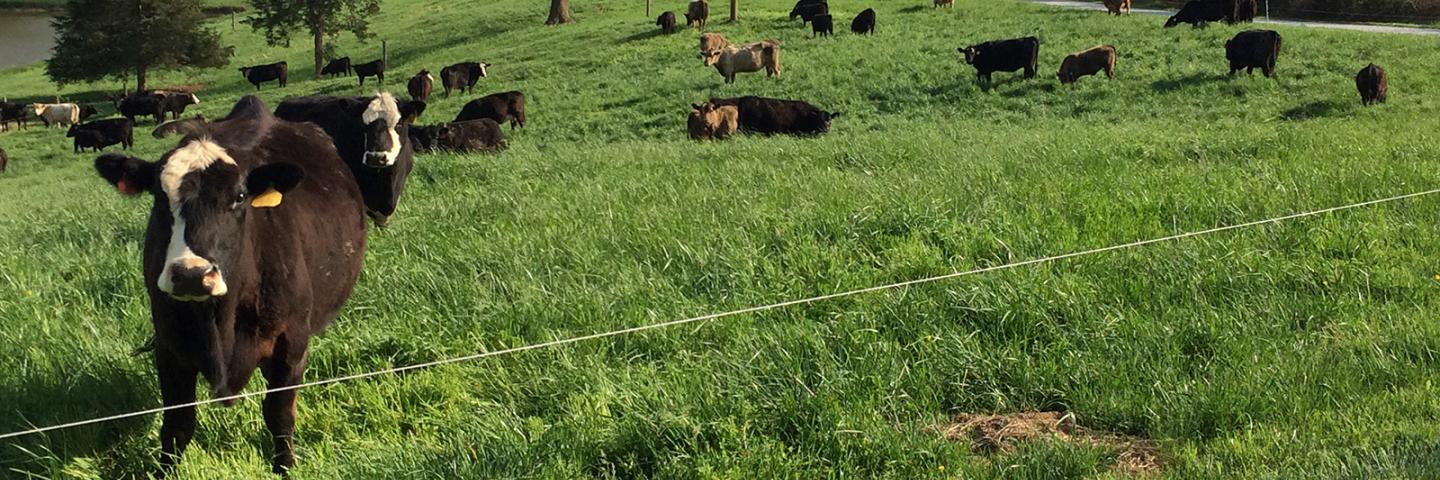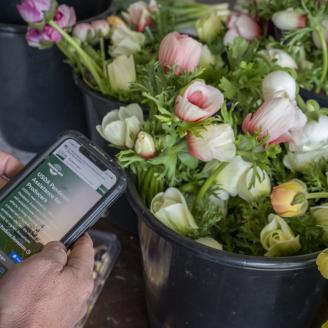Notice


The Environmental Quality Incentives Program (EQIP) provides financial and technical assistance to agricultural producers and non-industrial forest managers to address natural resource concern.
The Environmental Quality Incentives Program (EQIP) provides financial and technical assistance to agricultural producers and non-industrial forest managers to address natural resource concerns.
EQIP delivers environmental benefits such as improved water and air quality, conserved ground and surface water, increased soil health and reduced soil erosion and sedimentation, improved or created wildlife habitat, and mitigation against drought and increasing weather volatility.
How It Works
These voluntary conservation programs help producers make conservation work for them. Together, NRCS and producers invest in solutions that conserve natural resources for the future while improving agricultural operations.
Through EQIP, NRCS provides agricultural producers and non-industrial forest managers with financial resources and one-on-one help to plan and implement improvements, or what NRCS calls conservation practices. Using these practices can lead to cleaner water and air, healthier soil, and better wildlife habitat, all while improving agricultural operations. Through EQIP, you can voluntarily implement conservation practices and NRCS co-invests in these practices with you.
Benefits
Some of these benefits include:
- Reduction of contamination from agricultural sources, such as animal feeding operations.
- Efficient utilization of nutrients, reducing input costs, and reduction in nonpoint source pollution.
- Increased soil health to help mitigate against increasing weather volatility and improved drought resiliency.
EQIP Initiatives
Targeted EQIP financial assistance is available through several programmatic and landscape conservation initiatives.
Landscape Conservation Initiatives address priority natural resource concerns on the most vulnerable lands, target conservation assistance in high priority watersheds, or help stimulate the development and adoption of innovation and technology. Learn about Landscape Conservation Initiatives.
Accepted Applications
EQIP applications are accepted on a continuous basis, however, NRCS establishes application "cut-off" or submission deadline dates for evaluation, ranking and approval of eligible applications.
EQIP is open to all eligible agricultural producers and submitted applications may be considered or evaluated in multiple funding pool opportunities.
Eligibility
Agricultural producers and owners of industrial private forestland and Tribes are eligible to apply for EQIP. Eligible land includes cropland, rangeland, pastureland, non-industrial private forestland and other farm or ranch lands.
Applicants Must:
- Control or own eligible land.
- Comply with adjusted gross income imitation (AGI) provisions.
- Be in compliance with the highly erodible land and wetland conservation requirements.
- Develop a NRCS EQIP plan of operations.
- Additional restrictions and program requirements may apply.
Mississippi is proposing the following EQIP practices for increased payment rates capped at 90%:
-
Cover Crop (340) – grasses, legumes, and forbs planted for seasonal vegetative cover resulting in many possible conservation benefits.
-
Residue Management (329) – limiting soil disturbance to manage the amount, orientation and distribution of crop and plant residue on the soil surface year around.
-
Riparian Forest Buffer (391) – an area of predominantly trees and/or shrubs located adjacent to and up-gradient from watercourses or water bodies, such as streams, rivers, lakes, ponds, and wetlands.
-
Well Decommissioning (351) – the sealing and permanent closure of an inactive, abandoned, or unusable water or monitoring well.
-
Riparian Herbaceous Cover (390) – grasses, grass-like plants and forbs that are tolerant of intermittent flooding or saturated soils and that are established or managed in the transitional zone between terrestrial and aquatic habitats.
-
Forage and Biomass Planting (512) – establishing, reestablishing, or interseeding adapted and/or compatible species, or cultivars of herbaceous species suitable for pasture, hay, or biomass production.
-
Field Border (386) – a strip of permanent vegetation established at the edge or around the perimeter of a field. The primary purpose is to provide early successional habitat buffers for wildlife to provide food, nesting cover and escape cover for quail and other upland birds in cropland areas.
-
Filter Strip (393) – a strip or area of herbaceous vegetation that removes contaminants from overland flow. They are established where environmentally sensitive areas need to be protected from sediment, other suspended solids, and dissolved contaminants in runoff.
2018 Farm Bill EQIP Updates
Historically underserved (HU) participants are eligible for advance payments to help offset costs related to purchasing materials or contracting services through EQIP. HU participants may elect to receive an advance of not less than 50 percent of the EQIP conservation practice payment amount. Participants who receive advance payment must expend the funds within 90 days of receiving the advance.
The 2018 Farm Bill expanded eligibility criteria to allow water management entities who assist private agricultural producers with managing water distribution or conservation systems to apply for EQIP. These entities are defined as State, irrigation district, ground water management district, acequia, land grant-merced, or similar entity that has jurisdiction or responsibilities related to water delivery or management to eligible lands.
The 2018 Farm Bill requires that nationally 10 percent of mandatory program funding be targeted towards source water protection. States will identify priority source water protection areas and may offer increased incentives and higher payment rates for practices that address water quality and/or water quantity.
Beginning in 2020, States may provide increased payment rates for high-priority practices. In consultations with the State Technical Committee, State Conservationists may designate up to 10 practices to be eligible for increased payments. Eligible high-priority practices include those that address specific causes of ground or surface water impairment relating to excessive nutrients, address the conservation of water to advance drought mitigation and declining aquifers, meet other environmental priorities and priority resource concerns identified in habitat or area restoration plans, or is geographically targeted to address a natural resource concern in a specific watershed.
More Information

Contact
Contact: Earl McMillian
Assistant State Conservationist (Programs)
601.863.3905

News Releases
Additional Information
Apply for Environmental Quality Incentives Program (EQIP)
The Environmental Quality Incentives Program (EQIP) provides financial and technical assistance to agricultural producers and non-industrial forest managers.
Learn MoreHistorically Underserved Farmers and Ranchers
The Agriculture Improvement Act of 2018 (2018 Farm Bill) includes provisions that address socially disadvantaged, beginning, limited resource, and veteran farmers and ranchers (“historically underserved producers”).
Learn MoreFarm Bill
The 2018 Farm Bill was enacted on December 20, 2018. The Farm Bill continues its strong support for conservation efforts of America’s farmers and ranchers through reauthorization and expanded flexibility of NRCS conservation programs.
Learn MoreReady to get started?
Contact your local service center to start your application.
How to Get Assistance
Do you farm or ranch and want to make improvements to the land that you own or lease?
Natural Resources Conservation Service offers technical and financial assistance to help farmers, ranchers and forest landowners.

To get started with NRCS, we recommend you stop by your local NRCS field office. We’ll discuss your vision for your land.
NRCS provides landowners with free technical assistance, or advice, for their land. Common technical assistance includes: resource assessment, practice design and resource monitoring. Your conservation planner will help you determine if financial assistance is right for you.
We’ll walk you through the application process. To get started on applying for financial assistance, we’ll work with you:
- To fill out an AD 1026, which ensures a conservation plan is in place before lands with highly erodible soils are farmed. It also ensures that identified wetland areas are protected.
- To meet other eligibility certifications.
Once complete, we’ll work with you on the application, or CPA 1200.
Applications for most programs are accepted on a continuous basis, but they’re considered for funding in different ranking periods. Be sure to ask your local NRCS district conservationist about the deadline for the ranking period to ensure you turn in your application in time.
As part of the application process, we’ll check to see if you are eligible. To do this, you’ll need to bring:
- An official tax ID (Social Security number or an employer ID)
- A property deed or lease agreement to show you have control of the property; and
- A farm number.
If you don’t have a farm number, you can get one from USDA’s Farm Service Agency. Typically, the local FSA office is located in the same building as the local NRCS office. You only need a farm number if you’re interested in financial assistance.
NRCS will take a look at the applications and rank them according to local resource concerns, the amount of conservation benefits the work will provide and the needs of applicants. View Application Ranking Dates by State.
If you’re selected, you can choose whether to sign the contract for the work to be done.
Once you sign the contract, you’ll be provided standards and specifications for completing the practice or practices, and then you will have a specified amount of time to implement. Once the work is implemented and inspected, you’ll be paid the rate of compensation for the work if it meets NRCS standards and specifications.

